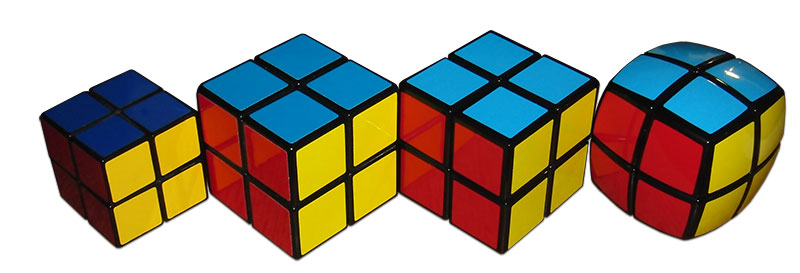
The Pocket Cube (also known as the Mini Cube and Twizzle) is a 2×2×2
combination puzzle
In mathematics, a combination is a selection of items from a set (mathematics), set that has distinct members, such that the order of selection does not matter (unlike permutations). For example, given three fruits, say an apple, an orange and a ...
invented in 1970 by American puzzle designer
Larry D. Nichols. The
cube
A cube or regular hexahedron is a three-dimensional space, three-dimensional solid object in geometry, which is bounded by six congruent square (geometry), square faces, a type of polyhedron. It has twelve congruent edges and eight vertices. It i ...
consists of 8 pieces, which are all corners.
History

In February 1970,
Larry D. Nichols invented a 2×2×2 "Puzzle with Pieces Rotatable in Groups" and filed a Canadian patent application for it. Nichols's cube was held together with magnets. Nichols was granted on April 11, 1972, two years before Rubik invented the
3×3×3 cube.
Nichols assigned his
patent
A patent is a type of intellectual property that gives its owner the legal right to exclude others from making, using, or selling an invention for a limited period of time in exchange for publishing an sufficiency of disclosure, enabling discl ...
to his employer Moleculon Research Corp., which sued
Ideal in 1982. In 1984, Ideal lost the patent infringement suit and appealed. In 1986, the appeals court affirmed the judgment that Rubik's 2×2×2 Pocket Cube infringed Nichols's patent, but overturned the judgment on Rubik's 3×3×3 Cube.
Group Theory

The
group theory
In abstract algebra, group theory studies the algebraic structures known as group (mathematics), groups.
The concept of a group is central to abstract algebra: other well-known algebraic structures, such as ring (mathematics), rings, field ( ...
of the
3×3×3 cube can be transferred to the 2×2×2 cube.
The elements of the group are typically the moves of that can be executed on the cube (both individual rotations of layers and composite moves from several rotations) and the group operator is a concatenation of the moves.
To analyse the group of the 2×2×2 cube, the cube configuration has to be determined. This can be represented as a
2-tuple, which is made up of the following parameters:
* Position of the corner pieces as a
bijective
In mathematics, a bijection, bijective function, or one-to-one correspondence is a function between two sets such that each element of the second set (the codomain) is the image of exactly one element of the first set (the domain). Equival ...
function (
permutation
In mathematics, a permutation of a set can mean one of two different things:
* an arrangement of its members in a sequence or linear order, or
* the act or process of changing the linear order of an ordered set.
An example of the first mean ...
)
* Orientation of the corner pieces as
vector
Vector most often refers to:
* Euclidean vector, a quantity with a magnitude and a direction
* Disease vector, an agent that carries and transmits an infectious pathogen into another living organism
Vector may also refer to:
Mathematics a ...
x
Two moves
and
from the set
of all moves are considered equal if they produce the same configuration with the same initial configuration of the cube. With the 2×2×2 cube, it must also be considered that there is no fixed orientation or top side of the cube, because the 2×2×2 cube has no fixed center pieces. Therefore, the
equivalence relation
In mathematics, an equivalence relation is a binary relation that is reflexive, symmetric, and transitive. The equipollence relation between line segments in geometry is a common example of an equivalence relation. A simpler example is equ ...
is introduced with
and
result in the same cube configuration (with optional rotation of the cube). This relation is
reflexive, as two identical moves transform the cube into the same final configuration with the same initial configuration. In addition, the relation is symmetrical and
transitive, as it is similar to the mathematical relation of
equality.
With this equivalence relation,
equivalence class
In mathematics, when the elements of some set S have a notion of equivalence (formalized as an equivalence relation), then one may naturally split the set S into equivalence classes. These equivalence classes are constructed so that elements ...
es can be formed that are defined with
on the set of all moves
. Accordingly, each equivalence class
 The Pocket Cube (also known as the Mini Cube and Twizzle) is a 2×2×2
The Pocket Cube (also known as the Mini Cube and Twizzle) is a 2×2×2  In February 1970, Larry D. Nichols invented a 2×2×2 "Puzzle with Pieces Rotatable in Groups" and filed a Canadian patent application for it. Nichols's cube was held together with magnets. Nichols was granted on April 11, 1972, two years before Rubik invented the 3×3×3 cube.
Nichols assigned his
In February 1970, Larry D. Nichols invented a 2×2×2 "Puzzle with Pieces Rotatable in Groups" and filed a Canadian patent application for it. Nichols's cube was held together with magnets. Nichols was granted on April 11, 1972, two years before Rubik invented the 3×3×3 cube.
Nichols assigned his  The
The
 The Pocket Cube (also known as the Mini Cube and Twizzle) is a 2×2×2
The Pocket Cube (also known as the Mini Cube and Twizzle) is a 2×2×2  In February 1970, Larry D. Nichols invented a 2×2×2 "Puzzle with Pieces Rotatable in Groups" and filed a Canadian patent application for it. Nichols's cube was held together with magnets. Nichols was granted on April 11, 1972, two years before Rubik invented the 3×3×3 cube.
Nichols assigned his
In February 1970, Larry D. Nichols invented a 2×2×2 "Puzzle with Pieces Rotatable in Groups" and filed a Canadian patent application for it. Nichols's cube was held together with magnets. Nichols was granted on April 11, 1972, two years before Rubik invented the 3×3×3 cube.
Nichols assigned his  The
The